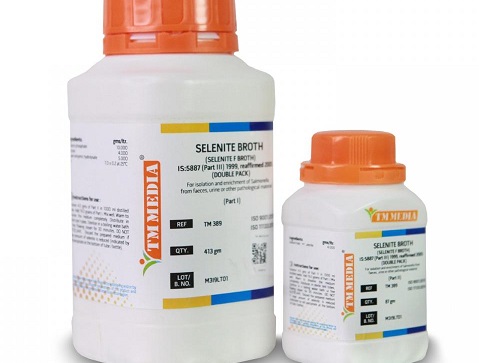In the microbiology laboratory, pure cultures of microorganisms (e.g., bacteria) are critical to the success of the next stages of the experiment to be undertaken. Thus, selective isolation of bacteria from samples (especially those suspected to contain mix bacteria) is usually performed in two steps:
- Growth of the bacteria in an enrichment medium or broth (e.g., selenite F broth).
- Plating on a selective (solid) agar.
The discovery of selenite F broth as an enrichment medium was based on the discovery that selenite was inhibitory to coliforms and certain bacterial species present in feacal and other environmental, food, water and other samples of sanitary importance. It later proved to be very effective for the isolation of Salmonella from feacal and other samples especially in scenarios where low numbers of this bacterium is present.
Coliforms are bacteria that are always present in the digestive tracts of humans and animals. They are found in the wastes of humans and animals, and can also be found in the soil. Coliforms are facultatively anaerobic, Gram-negative, non-spore-forming rods that ferment lactose vigorously to acid and gas at 35 ± 2 °C within 24 or 48 h.
Examples of coliforms are bacteria found in the genera: Enterobacteriaceae. Coliform bacteria are considered as indicator organisms because their presence in foods indicates that circumstances are suitable for the presence of enteric pathogens and may signify insufficient sanitary conditions.
Selenite is a chemical or compound that inhibits bacteria either by reacting with the sulfhydryl groups or by the formation of analogs of sulfur amino acids in the target bacteria. Selenite F broth is an enrichment medium. Enrichment medium are liquid culture media or broth that supports the growth of a particular bacterium while inhibiting the growth of unwanted bacteria present in the same sample (e.g., a stool samples, water, urine etc.).
Enrichment media are different from enriched media which are solid culture media that also contain additional growth nutrients (e.g., blood, vitamins) like enrichment media for the cultivation and isolation of fastidious bacteria (i.e., bacteria that require extra growth nutrient or molecules such as some factors in blood for their growth).
Selenite F broth is a selective liquid medium (broth) that inhibits certain bacteria such as Escherichia coli, Shigella and Enterococcus while allowing some select bacteria such as Proteus, Pseudomonas, and Salmonella to grow. They are particularly used for the initial culture of stool samples prior to their sub-culturing onto solid culture media such as MacConkey agar, Eosin methylene blue (EMB) agar and desoxycholate citrate agar (DCA).
Selenite F broth is clinically used for the examination of feacal smaples for the isolation of bacterial pathogens. They are also used for the investigation of food samples suspected to contain certain foodborne pathogens such as Salmonella. It is important to always use freshly prepared selenite F broth because the presence of red precipitates in old medium may give rise to a false-positive reaction.
The use of selenite F broth as an enrichment medium is critical to the isolation of the suspect bacterial pathogen from the samples (clinical stool samples, environmental samples or food samples) being investigated because selenite F broth has the capacity to increase the sensitivity of the direct culture of the (stool or food) samples. Other selectiveenrichment medium that can be used apart from selenite F broth includes tetrathionate broth and Rappaport-Vassiliadis (RV) medium.
Selenite F broth is useful for detecting Salmonella in the non-acute stages of illness when organisms occur in the faeces in low numbers. It can also be used for epidemiological studies to enhance the detection of low number of bacteria from asymptomatic or convalescent patients.
Selenite F broth contains casein peptone which provides essential nitrogenous and carbon compounds that facilitates bacterial enrichment. In addition, the lactose present in selenite F broth helps to maintain a uniform pH during usage. A freshly prepared selenite F broth appears golden-like in colour (Figure 1).

When used for the enrichment or culture of a sample, a positive test result is seen as colourless good growth while a negative test result is seen as pink with some bile precipitates, inhibited growth or no growth. Note: growth in such broth medium as selenite F broth is indicated or inferred by the presence or absence of turbidity in the medium.
Component of selenite F broth
Pancreatic digest of casein
Lactose
Sodium selenite
Sodium phosphate
Principle of selenite F broth use: Casein enzymic hydrolysate provides nitrogenous substances. Lactose maintains the pH of medium. Selenite is reduced by bacterial growth and alkali is produced. An increase in pH lessens the toxicity of the selenite and results in overgrowth of other bacteria. The acid produced by bacteria due to lactose fermentation serves to maintain a neutral pH. Sodium phosphate maintains a stable pH and also lessens the toxicity of selenite.
Storage and Shelf-life: Selenite F broth should be stored below 30°C in tightly closed container and the prepared medium at 2 – 8°C. It should be used before the expiry date on the label.
Discover more from #1 Microbiology Resource Hub
Subscribe to get the latest posts to your email.



